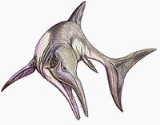
Platypterygius
Encyclopedia
Platypterygius was an ichthyosaur
of the family Ophthalmosauridae
. It is most closely related to the genera
Caypullisaurus
and Brachypterygius
.
s are known from Australia
, Russia
, United States of America, Colombia
, Western Europe
and possibly New Zealand
. There are seven named species. Both adults and juveniles have been unearthed, including newborns and pregnant females. Like other ichthyosaurs, Platypterygius gave live birth.
The remains from Australia were originally called Ichthyosaurus
australis. They are from the Toolebuc Formation and Allaru Mudstone (Albian
, Lower Cretaceous) of Flinders River and other localities in north central Queensland. In 1990 Wade erected the species name P. longmani to include all remains previously referred to I.australis .
 Platypterygius reached a length of about 7 meters. It had a long snout and a powerful finned tail. There are more digits in the front flippers than is usual in ichthyosaurs; they are tightly bound in rows, giving a broad, flat appearance . This unusual characteristic gives the genus its name, meaning 'flat wing.' Furthermore, some of the wrist bones have disappeared entirely . CAT scans on a juvenile specimen strongly suggest that Platypterygius was deaf .
Platypterygius reached a length of about 7 meters. It had a long snout and a powerful finned tail. There are more digits in the front flippers than is usual in ichthyosaurs; they are tightly bound in rows, giving a broad, flat appearance . This unusual characteristic gives the genus its name, meaning 'flat wing.' Furthermore, some of the wrist bones have disappeared entirely . CAT scans on a juvenile specimen strongly suggest that Platypterygius was deaf .
Ichthyosaur
Ichthyosaurs were giant marine reptiles that resembled fish and dolphins...
of the family Ophthalmosauridae
Ophthalmosauridae
Ophthalmosauridae is an extinct family of thunnosaur ichthyosaurs from the Middle Jurassic to the early Late Cretaceous of Asia, Australia, Europe, North America and South America. Currently, the oldest known ophthalmosaurid is Mollesaurus from the early Bajocian of Argentina. Named by George H...
. It is most closely related to the genera
Genus
In biology, a genus is a low-level taxonomic rank used in the biological classification of living and fossil organisms, which is an example of definition by genus and differentia...
Caypullisaurus
Caypullisaurus
Caypullisaurus is an extinct genus of large ichthyosaur from the Late Jurassic to the Early Cretaceous of Argentina. Its holotype was collected from the Vaca Muerta Formation of Cerro Lotena, Neuquen, dating to the early Tithonian stage of the Late Jurassic, about 150 million years ago...
and Brachypterygius
Brachypterygius
Brachypterygius is a genus of ophthalmosaurid ichthyosaur known from England and European Russia. Brachypterygius was named by Friedrich von Huene in 1922 and the type species is therefore Brachypterygius extremus. The holotype of B. extremus is known from Kimmeridgian stage of the Late Jurassic of...
.
Discovery and species
FossilFossil
Fossils are the preserved remains or traces of animals , plants, and other organisms from the remote past...
s are known from Australia
Australia
Australia , officially the Commonwealth of Australia, is a country in the Southern Hemisphere comprising the mainland of the Australian continent, the island of Tasmania, and numerous smaller islands in the Indian and Pacific Oceans. It is the world's sixth-largest country by total area...
, Russia
Russia
Russia or , officially known as both Russia and the Russian Federation , is a country in northern Eurasia. It is a federal semi-presidential republic, comprising 83 federal subjects...
, United States of America, Colombia
Colombia
Colombia, officially the Republic of Colombia , is a unitary constitutional republic comprising thirty-two departments. The country is located in northwestern South America, bordered to the east by Venezuela and Brazil; to the south by Ecuador and Peru; to the north by the Caribbean Sea; to the...
, Western Europe
Europe
Europe is, by convention, one of the world's seven continents. Comprising the westernmost peninsula of Eurasia, Europe is generally 'divided' from Asia to its east by the watershed divides of the Ural and Caucasus Mountains, the Ural River, the Caspian and Black Seas, and the waterways connecting...
and possibly New Zealand
New Zealand
New Zealand is an island country in the south-western Pacific Ocean comprising two main landmasses and numerous smaller islands. The country is situated some east of Australia across the Tasman Sea, and roughly south of the Pacific island nations of New Caledonia, Fiji, and Tonga...
. There are seven named species. Both adults and juveniles have been unearthed, including newborns and pregnant females. Like other ichthyosaurs, Platypterygius gave live birth.
The remains from Australia were originally called Ichthyosaurus
Ichthyosaurus
Ichthyosaurus is an extinct genus of ichthyosaur from the Early Jurassic of Europe . It is among the best known ichthyosaur genera, with the Order Ichthyosauria being named after it...
australis. They are from the Toolebuc Formation and Allaru Mudstone (Albian
Albian
The Albian is both an age of the geologic timescale and a stage in the stratigraphic column. It is the youngest or uppermost subdivision of the Early/Lower Cretaceous epoch/series. Its approximate time range is 112.0 ± 1.0 Ma to 99.6 ± 0.9 Ma...
, Lower Cretaceous) of Flinders River and other localities in north central Queensland. In 1990 Wade erected the species name P. longmani to include all remains previously referred to I.australis .
Palaeobiology


